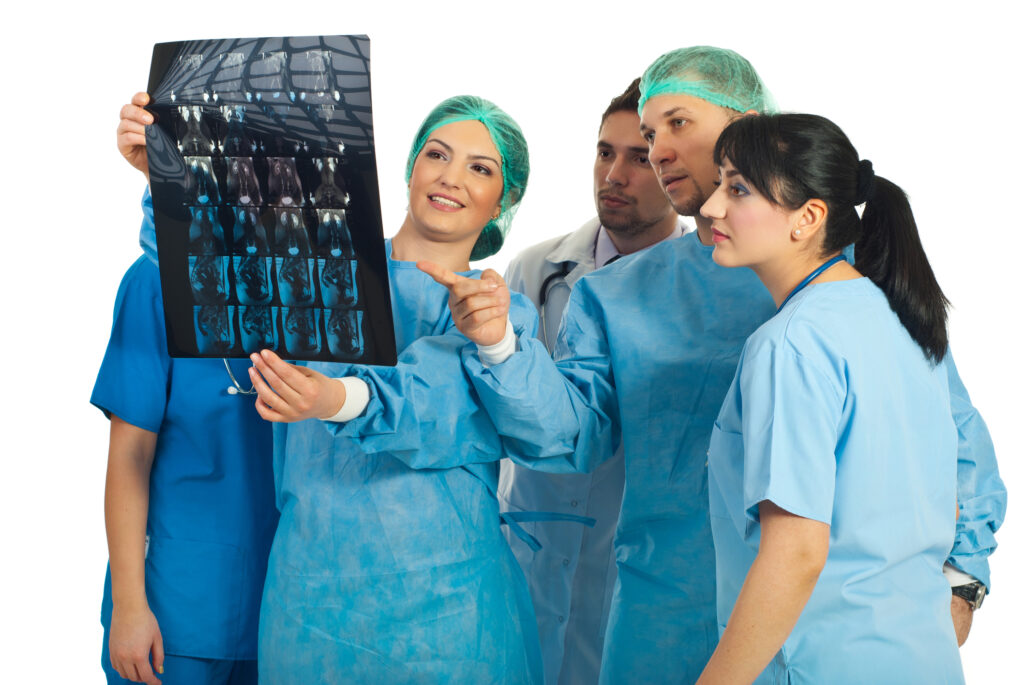If you’re looking to become a medical imaging professional, you’ll need to do specialist studies. Unfortunately, a basic BSN nursing degree or undergraduate course in medicine won’t cut it, and you’ll need to pursue a postgraduate education to enter this specialised field. So whether you’re considering a DNP vs PhD, the fact is that either may be necessary to excel as a licensed radiologist.
For our comprehensive guide to education and upskilling in the field of medical imaging, just keep reading.
Medical Imaging: What is It?
So, what is medical imaging? Commonly referred to as either radiology or radiography, the process of creating medical images takes several forms. These include:
Ultrasound
Ultrasound imaging utilises the phenomenon of sonography to see inside us. Sonography is, of course, the use of high-frequency waves of sound for medical purposes. By emitting these sound waves, ultrasound images of our internal bits and bobs can be digitally created.
MRI
Short for Magnetic Resonance Imaging, MRI technology relies on, quite unsurprisingly, the power of magnets. Rather than using sound waves, MRI machines release electromagnetic energy to produce digital images of the body’s insides. Due to the versatility of MRI technology, it can be applied to virtually any part of the body.
X-rays
X-ray machines, on the other hand, use radiation. Also known as electromagnetic energy beams, this radiation is then used to form digital pictures of the bones and soft tissues that make up the body. This can be especially useful in identifying breakages or other forms of illness or disease.
Getting Into Professional Medical Imaging: What Job Prospects Are Available in the Field?
Being qualified in radiology can open the door to many rewarding, challenging, and exciting careers in medical imaging.
Some of the available job options for medical imaging graduates can include:
Option 1: Become a Radiologist
A radiologist’s area of expertise lies in using X-ray technology to assist with diagnosing and treating illnesses and complications in the body. These can include identifying fractured and broken bones and also diagnosing other types of diseases – such as tumours and various types of cancer.
Option 2: Become a Radiologist RadiationTherapist
Working closely and in collaboration with radiologists, a radiation therapist is tasked with performing radiation therapy to cure illnesses and diseases. Often, this will be a key component of cancer treatment. For this reason, individuals who are best suited to a career as a radiation therapist must display genuine empathy and be able to deliver compassionate care.
Option 3: Become a Diagnostic Sonographer
Diagnostic sonographers are reliant on the use of ultrasound technology to be able to perform their craft. Due to the efficiency of ultrasounds in being able to identify and view unborn fetuses, medical sonography has become central to delivering prenatal treatment and care.
Option 4: Become an MRI Technologist
As an MRI technologist, you will be well-versed in creating medical images through the use of magnetic fields. Often, your patients will be required to get inside large, confining ‘tubes’ to be surrounded by the magnetic energy field. This can be distressing for some patients. As such, the MRI technologist needs to be reassuring and act as a calming presence for the patient undergoing the procedure.
Option 5: Become a Cardiovascular Technologist
If you’re specialised in performing ultrasounds of the heart, it follows that your title will be a cardiovascular technologist. Also known as electrocardiograms, these types of procedures can be invasive and require specialised training and education.
Option 6: Become a Nuclear Medicine Technologist
Nuclear medicine technologists are highly trained professionals. As the title would suggest, they use nuclear medicine to diagnose and treat diseases in the body. This involves administering what is known as ‘radiopharmaceuticals’ to deliver and perform treatment for medical issues.
Granted, each of these professions requires you to be fully accredited to be able to perform it. As such, it’s important to complete the relevant formal qualifications before pursuing any of these career paths. Once you’re qualified, however, you can expect your profession to always be in demand. In addition to this, your earning potential will be high. Medical imaging is one of the most lucrative professions there is, and as such, the financial reward is worth the specialisation.
Disclaimer
The information provided in A Guide to Education and Upskilling for Professionals in the Medical Imaging Field is intended for general informational and educational purposes only. While every effort has been made to ensure the accuracy and relevance of the content at the time of publication (21 December 2023), Open Medscience does not guarantee the completeness, reliability, or ongoing validity of the information.
This guide is not a substitute for professional advice, accreditation requirements, or regulatory guidance. Readers are strongly encouraged to consult with relevant educational institutions, licensing bodies, or healthcare authorities before making any decisions related to career progression or academic enrolment in the field of medical imaging.
Open Medscience accepts no liability for any loss, damage, or inconvenience caused as a result of reliance on any material contained in this publication.
You are here: home » diagnostic medical imaging blog »



